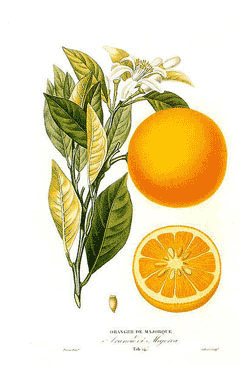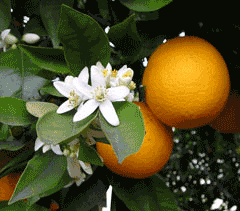 |
|
http://commons.wikimedia.org/wiki/File:Histoire_et_culture_des_orangers_A._Risso_et_A._Poiteau._--_Paris_Henri_Plon,_Editeur,_1872.jpg |
 |
| http://commons.wikimedia.org/wiki/User:EugeneZelenko Citrus x meyeri |
Translate this page:
Summary
Bloom Color: White. Main Bloom Time: Early spring, Early winter, Late spring, Late winter, Mid spring, Mid winter. Form: Rounded.
Physical Characteristics

 Citrus_sinensis is an evergreen Tree growing to 9 m (29ft 6in) at a medium rate.
Citrus_sinensis is an evergreen Tree growing to 9 m (29ft 6in) at a medium rate.
See above for USDA hardiness. It is hardy to UK zone 9 and is frost tender. It is in leaf all year. The species is hermaphrodite (has both male and female organs) and is pollinated by Apomictic (reproduce by seeds formed without sexual fusion), insects. The plant is self-fertile.
It is noted for attracting wildlife.
Suitable for: medium (loamy) and heavy (clay) soils and prefers well-drained soil. Suitable pH: mildly acid, neutral and basic (mildly alkaline) soils and can grow in very acid and very alkaline soils.
It cannot grow in the shade. It prefers moist soil.
UK Hardiness Map
US Hardiness Map
Synonyms
C. aurantium sinensis.
Plant Habitats
Edible Uses
Fruit - raw. Sweet and delicious[1, 3, 46, 61]. The juice is often extracted from the fruit and sold as a refreshing and healthy drink or used in jellies, ice cream etc[183]. The rind of the fruit is often used as a flavouring in cakes etc or made into marmalade[1, 46, 183]. Flowers - cooked as a vegetable or made into a tea[183].
References More on Edible Uses
Medicinal Uses
Plants For A Future can not take any responsibility for any adverse effects from the use of plants. Always seek advice from a professional before using a plant medicinally.
Citrus species contain a wide range of active ingredients and research is still underway in finding uses for them. They are rich in vitamin C, flavonoids, acids and volatile oils. They also contain coumarins such as bergapten which sensitizes the skin to sunlight. Bergapten is sometimes added to tanning preparations since it promotes pigmentation in the skin, though it can cause dermatitis or allergic responses in some people[238]. Some of the plants more recent applications are as sources of anti-oxidants and chemical exfoliants in specialized cosmetics[238]. The fruit is appetizer and blood purifier[240]. It is used to allay thirst in people with fevers and also treats catarrh[240]. The fruit juice is useful in the treatment of bilious affections and bilious diarrhoea[240]. The fruit rind is carminative and tonic[240]. The fresh rind is rubbed on the face as a cure for acne[240]. The dried peel is used in the treatment of anorexia, colds, coughs etc[218].
References More on Medicinal Uses
The Bookshop: Edible Plant Books
Our Latest books on Perennial Plants For Food Forests and Permaculture Gardens in paperback or digital formats.

Edible Tropical Plants
Food Forest Plants for Hotter Conditions: 250+ Plants For Tropical Food Forests & Permaculture Gardens.
More

Edible Temperate Plants
Plants for Your Food Forest: 500 Plants for Temperate Food Forests & Permaculture Gardens.
More

More Books
PFAF have eight books available in paperback and digital formats. Browse the shop for more information.
Shop Now
Other Uses
A semi-drying oil obtained from the seed is used in soap making[46, 61]. An essential oil from the peel is used as a food flavouring and also in perfumery and medicines[1, 46, 61]. 1. Nectary - Flowers rich in nectar and pollen:
Yes – Citrus flowers are rich in nectar and pollen, making them highly attractive to pollinators like bees.
2. Wildlife - Food (Fruit, Seeds, Leaf litter, Shelter, Nesting, Roosting):
Yes – The fruits are a food source for various wildlife, including birds and mammals. The dense foliage of citrus trees can also provide shelter for nesting and roosting birds.
3. Invertebrate Shelter (Overwintering sites, Leaf litter, Groundcover):
Yes – The dense leaf litter under citrus trees can offer overwintering sites for invertebrates, and the rough bark of mature trees can be used by beneficial insects.
4. Pest Confuser (Smell):
Yes – The strong citrus scent from the leaves and fruit can act as a natural pest deterrent, helping to confuse or repel certain insects.
Special Uses
References More on Other Uses
Cultivation details
Landscape Uses:Espalier, Standard, Specimen. Prefers a moderately heavy loam with a generous amount of compost and sand added and a very sunny position[1, 200]. Prefers a pH between 5 and 6[200]. Tolerates a pH in the range 4.3 to 8.3. Plants are intolerant of water logging[3]. When growing plants in pots, a compost comprising equal quantities of loam and leafmould plus a little charcoal should produce good results[260]. Do not use manure since Citrus species dislike it[260]. When watering pot plants it is important to neither overwater or underwater since the plant will soon complain by turning yellow and dying. Water only when the compost is almost dry, but do not allow it to become completely dry[260]. The sweet orange is widely grown for its edible fruit in warm temperate and tropical zones, there are many named varieties[183]. In Britain it can be grown in a pot placed outdoors in the summer and brought into a greenhouse during the winter[3]. Plants are almost hardy in the mildest areas of Britain[1] but the fruit is insipid if it is developed when the mean temperature is below 18°c[3]. The young growth in spring, even on mature plants, is frost-tender and so it is best to grow the plants in a position sheltered from the early morning sun[K]. The flowers are sweetly scented[245]. Plants dislike root disturbance and so should be placed into their permanent positions when young. If growing them in pots, great care must be exercised when potting them on into larger containers[238]. Special Features:Edible, Not North American native, Naturalizing, Attracts butterflies, Fragrant flowers, Attractive flowers or blooms. Citrus fruits are generally harvested in late autumn to early spring, depending on the specific variety and local climate.
Citrus trees usually flower in the spring. Some species may have a second flowering period in late summer. Most Citrus species are self-fertile, meaning they can produce fruit without needing another plant for cross-pollination, though cross-pollination can improve fruit set in some varieties.
References Carbon Farming Information and Carbon Sequestration Information
Temperature Converter
Type a value in the Celsius field to convert the value to Fahrenheit:
Fahrenheit:
The PFAF Bookshop
Plants For A Future have a number of books available in paperback and digital form. Book titles include Edible Plants, Edible Perennials, Edible Trees,Edible Shrubs, Woodland Gardening, and Temperate Food Forest Plants. Our new book is Food Forest Plants For Hotter Conditions (Tropical and Sub-Tropical).
Shop Now
Plant Propagation
The seed is best sown in a greenhouse as soon as it ripe after thoroughly rinsing it[164, 200]. Sow stored seed in March in a greenhouse[3]. Germination usually takes place within 2 - 3 weeks at 13°c. Seedlings are liable to damp off so they must be watered with care and kept well ventilated. The seed is usually polyembrionic, two or more seedlings arise from each seed and they are genetically identical to the parent but they do not usually carry any virus that might be present in the parent plant[200]. When large enough to handle, prick the seedlings out into individual pots and grow them on in the greenhouse for at least three growing seasons before trying them outdoors. Plant them out in the summer and give them some protection from the cold for their first few winters outdoors. Cuttings of half-ripe wood, July/August in a frame. Layering in October.
Other Names
If available other names are mentioned here
Native Range
Hybrid. The hybrid formula is C. maxima × C. maxima × C. reticulata.
Weed Potential
Right plant wrong place. We are currently updating this section.
Please note that a plant may be invasive in one area but may not in your area so it's worth checking.
Conservation Status
IUCN Red List of Threatened Plants Status :

Growth: S = slow M = medium F = fast. Soil: L = light (sandy) M = medium H = heavy (clay). pH: A = acid N = neutral B = basic (alkaline). Shade: F = full shade S = semi-shade N = no shade. Moisture: D = dry M = Moist We = wet Wa = water.
Now available:
Food Forest Plants for Mediterranean Conditions
350+ Perennial Plants For Mediterranean and Drier Food Forests and Permaculture Gardens.
[Paperback and eBook]
This is the third in Plants For A Future's series of plant guides for food forests tailored to
specific climate zones. Following volumes on temperate and tropical ecosystems, this book focuses
on species suited to Mediterranean conditions—regions with hot, dry summers and cool, wet winters,
often facing the added challenge of climate change.
Read More
Expert comment
Author
(L.)Osbeck.
Botanical References
200
Links / References
For a list of references used on this page please go here
Readers comment